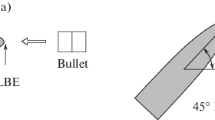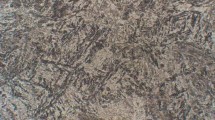Abstract
Foreign Object Damage (FOD) usually happens when objects are ingested into jet engines powering military or civil aircraft. Under extreme conditions, FOD can lead to severe structural damage. More commonly it produces local impacted sites of the fan and compressor airfoils, lowering fatigue life of these components. FOD is a prime cause for maintenance and repair in aircraft engines. In this paper, a framework for analyzing FOD and its effect on fatigue cracking is established. A finite element analysis is used to identify three relevant regimes of FOD related to the depth of penetration into the substrate, and to determine the residual stresses. Most of the emphasis in this paper focuses on fatigue cracks emerging from shallow indentations, which are generally expected to be of most practical concern. Full three-dimensional finite element solutions are obtained for semi-circular surface cracks emerging from specific locations at the indentation revealing the influence of the residual stress on the stress intensity factor distribution. For shallow indents, a relatively simple dimensionless formula for the relation between the residual stress intensity factor, the crack size, and the indentation width are developed. These results, together with results for the intensity factor variations due to cyclic loading, have been used to address the question: To what extent do the residual stresses caused by the FOD reduce the critical crack size associated with threshold fatigue crack growth? Formulas for the critical crack size are obtained. Specific results are presented for the blade alloy, Ti-6Al-4V, revealing that FOD can reduce the critical crack size by as much as 60%.
Similar content being viewed by others
References
Begley, M., Evans, A.G. and Hutchinson, J.W. (1999). Spherical impression of thin elastic films on elastic-plastic substrates. International Journal of Solids and Structures, submitted.
Biwa, S. and Storakers B. (1995). Ananalysis of fully plastic Brinell indentation. J. Mech. Phys. Solids 43, 1303–1334.
Bower, A.F., Fleck, N.A., Needleman, A. and Ogbonna, N. (1993). Indentation of power law creeping solids. Proceeding Royal Society of London A441, 97–124.
Hibbit, Karlsson & Sorensen Inc. (1998). ABAQUS version 5.7 User's Manual, Hibbit, Karlsson & Sorensen Inc., Pawtucket, RI.
Hill, R., Storakers, B. and Zdunek, A.B. (1989). A theoretical study of the Brinell hardness test. Proceedings Royal Society of London A423, 301–330.
Johnson, K.L. (1985). Contact Mechanics, Cambridge University Press, Cambridge.
Mesarovic, S.D. and Fleck, N.A. (1999a). Spherical indentation of elastic-plastic solids. Proceeding Royal Society London, in press.
Mesarovic, S.D. and Fleck, N.A. (1999b). Frictionless indentation of dissimilar elastic-plastic spheres. International Journal of Solids and Structures, in press.
Peters, J.O., Roder, O., Boyce, B.L., Thompson, A.W. and Ritchie, R.O. (2000). Role of Foreign Object Damage on Thresholds for High-Cycle Fatigue in Ti-6Al-4V. Metallurgical and Materials Transactions A, in review.
Ritchie, R.O., Davidson, D.L., Boyce, B.L., Campbell, J.P. and Roder, O. (1999). High-Cycle Fatigue of Ti-6Al-4V. Fatigue and Fracture of Engineering Materials and Structures 22, 621–631.
Author information
Authors and Affiliations
Rights and permissions
About this article
Cite this article
Chen, X., Hutchinson, J.W. Foreign object damage and fatigue crack threshold: Cracking outside shallow indents. International Journal of Fracture 107, 31–51 (2001). https://doi.org/10.1023/A:1026543021702
Issue Date:
DOI: https://doi.org/10.1023/A:1026543021702




